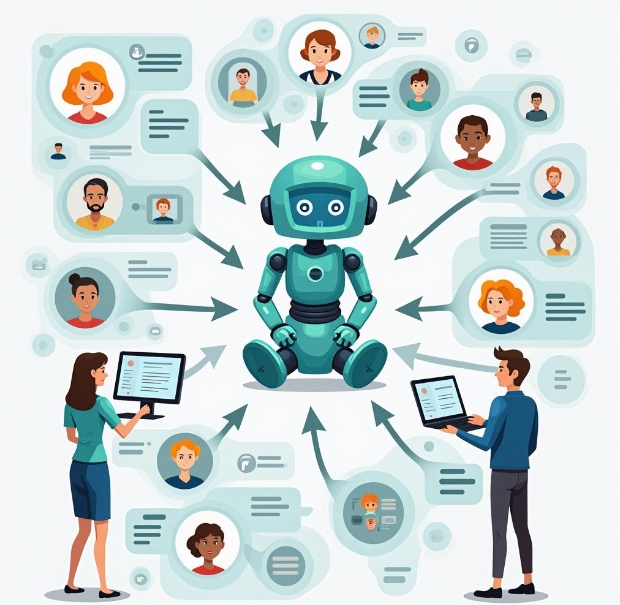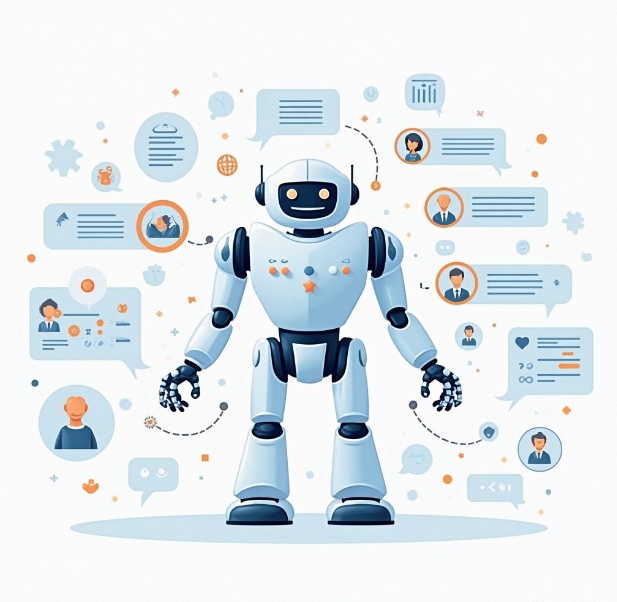Chatbot Development and Programming: The Innovative Engine of the Intelligent Interaction Era
- latest articles
- 1.DApp Development & Customization: Merging Diverse Market Needs with User Experience 2.Analysis of the Core Technical System in DApp Project Development 3.How to achieve cross-chain interoperability in Web3 projects? 4.How does the tokenization of points reconstruct the e-commerce ecosystem? 5.How to Set and Track Data Metrics for a Points Mall? 6.What is DApp Development? Core Concepts and Technical Analysis 7.Inventory of commonly used Web3 development tools and usage tips 8.Development of a Distribution System Integrated with Social E-commerce 9.Six Key Steps for Businesses to Build a Points Mall System 10.What is DApp Development? A Comprehensive Guide from Concept to Implementation
- Popular Articles
- 1.Future Trends and Technology Predictions for APP Development in 2025 2.Analysis of the DeFi Ecosystem: How Developers Can Participate in Decentralized Finance Innovation 3.From Zero to One: How PI Mall Revolutionizes the Traditional E-commerce Model 4.DAPP Development | Best Practices for Professional Customization and Rapid Launch 5.Recommended by the Web3 developer community: the most noteworthy forums and resources 6.From Cloud Computing to Computing Power Leasing: Building a Flexible and Scalable Computing Resource Platform 7.How to Develop a Successful Douyin Mini Program: Technical Architecture and Best Practices 8.Shared Bike System APP: The Convenient Choice in the Era of Smart Travel 9.How to Create a Successful Dating App: From Needs Analysis to User Experience Design 10.From Design to Development: The Complete Process of Bringing an APP Idea to Life
In the current era of booming artificial intelligence, chatbots have become one of the core technologies of intelligent interaction. Whether in daily life, education and training, or enterprise services, chatbots are transforming the way we communicate in unprecedented ways. As an innovative engine of the intelligent interaction era, the development and programming of chatbots are underpinned by rich technological and design considerations. This article will delve into the development background, core principles, application scenarios, and future prospects of chatbots.
I. The Rise of Chatbots: From Basic Tools to Intelligent Assistants
The history of chatbots dates back to the 1960s when Joseph Weizenbaum of MIT developed an early program called ELIZA. ELIZA used simple rules to mimic the language patterns of psychotherapists, sparking significant interest in computers' ability to simulate human conversation. However, ELIZA's limitation was its inability to understand semantics, relying more on keyword matching as a form of "pseudo-intelligence."
Entering the 21st century, with the rapid development of natural language processing (NLP), deep learning, and speech recognition technologies, chatbots have evolved from "mechanical" to "intelligent." Modern chatbots can not only understand context but also continuously optimize dialogue strategies through learning. This progress is attributed to the support of several core technologies:
1. Natural Language Processing (NLP)
NLP technology enables chatbots to analyze and understand the grammar and semantics of user language, achieving natural and smooth interaction.
2. Machine Learning
Through training on large datasets, chatbots can continuously improve their conversational abilities and predict user needs.
3. Speech Recognition and Synthesis
With the rise of voice assistants like Siri and Alexa, voice interaction has become an important direction for chatbot development.
II. Core Principles of Chatbots: The Logic Behind Intelligent Interaction
The development and programming of chatbots are not merely a matter of stacking technologies but the result of interdisciplinary integration. Their core principles include information extraction, semantic matching, and dialogue management.
1. Information Extraction: Capturing User Intent from Vast Data
Information extraction is the first step in a chatbot's operation, aiming to identify key content from user input, whether text or speech. For example, when a user asks, "What's the weather like today?" the chatbot needs to recognize "weather" as the topic and "today" as the time.
2. Semantic Matching: Achieving "Mind Reading" Between Humans and Machines
Semantic matching analyzes the deeper meaning of user language to determine the underlying intent. Thanks to deep learning technology, modern chatbots can use semantic vector space models to understand complex language structures.
3. Dialogue Management: The Art of Intelligent Responses
Dialogue management is the "brain" of a chatbot, generating appropriate responses based on contextual information. Whether rule-based systems or generative model-based systems, the goal of dialogue management is to enhance the coherence and naturalness of conversations.

III. Application Scenarios: From Virtual Customer Service to Multi-Domain Empowerment
Chatbots have made their mark in multiple fields, bringing transformative impacts to various industries.
1. Customer Service: Enhancing Efficiency and User Experience
In e-commerce and banking, chatbots are widely used in customer service systems. They can quickly handle common queries, such as order tracking and account management, significantly reducing the burden on human agents.
2. Education: Personalized Learning Assistants
Online learning systems based on chatbots can provide students with personalized learning recommendations. For example, AI tutoring systems can automatically adjust course content based on a student's progress.
3. Healthcare: Health Consultation and Psychological Support
In the healthcare industry, chatbots are used for preliminary health consultations and psychological support services. For instance, AI mental health assistants can identify users' emotional states through conversation and offer advice.
4. Smart Homes: Ubiquitous Voice Assistants
Chatbots in smart speakers and home automation systems allow users to perform daily tasks like adjusting lights and playing music through voice commands.
IV. Key Challenges in Development and Programming
Despite significant achievements, the development of chatbots still faces numerous challenges.
1. Multilingual Support
Achieving high-quality multilingual conversations requires extensive annotated data and optimization of language models.
2. Emotional Understanding and Expression
How to enable chatbots to exhibit appropriate emotional responses in conversations remains an urgent problem to solve.
3. Data Privacy and Security
Chatbots handle large amounts of user data, and ensuring data security and privacy presents both ethical and technical challenges for developers.

V. Future Prospects: Evolution from Tools to Partners
With further advancements in AI technology, chatbots are expected to become "digital partners" for humans, providing support in various aspects. Here are some key trends:
1. Smarter Emotional Interaction
Future chatbots will be able to perceive user emotions more accurately and provide more empathetic responses.
2. Deep Integration with the Internet of Things (IoT)
As IoT becomes more widespread, chatbots will serve as bridges between smart devices, building a seamlessly connected intelligent ecosystem.
3. Integration with Augmented Reality (AR) and Virtual Reality (VR)
In AR/VR environments, chatbots can act as virtual guides, offering users immersive interactive experiences.
VI. Conclusion: Ushering in a New Era of Intelligent Interaction
As a key innovative engine of the intelligent interaction era, chatbots have not only changed the way humans and machines communicate but have also given rise to new business models and service forms across multiple fields. Although the development process is fraught with challenges, with continuous technological breakthroughs, we have reason to believe that chatbots will play an even broader and more profound role in the future.
-

How does artificial intelligence technology transform the operational models of modern enterprises?
In the wave of the digital era, artificial intelligence (AI) technology has tran···
-

How to Utilize Artificial Intelligence for Precision Medicine and Health Management
With the rapid advancement of technology, artificial intelligence (AI) has demon···
-

Integration and Application of Artificial Intelligence and Robotics
In today's era of rapid technological advancement, the integration of artificial···

 Blockchain
Blockchain










